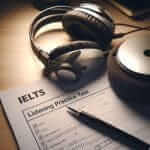“Both…and” is a common grammatical structure in English, used to emphasize the inclusion of two elements. It frequently appears in IELTS exams, testing your ability to express ideas clearly and concisely. Understanding its correct usage can significantly enhance your grammar score. Let’s explore how “both…and” functions in various sections of the IELTS exam.
Example Sentences:
- Speaking: “I enjoy both reading books and watching movies in my free time.” (Here, “both…and” emphasizes the speaker enjoys both activities equally.)
- Writing Task 1: “The graph illustrates that both the number of cars and the level of air pollution increased significantly over the decade.” (This sentence effectively compares the trends of two variables in a graph.)
- Writing Task 2: “Some people believe that technology has both positive and negative impacts on society.” (This sentence introduces a common IELTS essay topic, discussing two sides of an argument.)
 IELTS Exam Preparation
IELTS Exam Preparation
Understanding “Both…and” in IELTS
1. Meaning and Significance
“Both…and” is a correlative conjunction, connecting two words, phrases, or clauses of equal grammatical rank and emphasizing their combined importance. It signals to the reader or listener that two things are being considered together.
2. Structure and Usage
Formula:
Both + [Element 1] + and + [Element 2]
Example:
- Both the students and the teacher were excited about the field trip.
Parts of Speech:
- Elements: Nouns, verbs, adjectives, adverbs, phrases, or clauses.
Placement:
- Before nouns: Both the cat and the dog are sleeping.
- Before verbs: He both sings and dances professionally.
- Before adjectives: The food was both delicious and affordable.
Applying “Both…and” in IELTS
1. Speaking
Use “both…and” to express a preference for two things, compare your interests, or describe your daily routine effectively.
Example:
“I find both history and science fascinating subjects to study.”
2. Writing Task 1
Employ “both…and” to present a clear comparison between two trends in graphs, charts, or diagrams.
Example:
“As the graph depicts, both online sales and customer satisfaction increased steadily from 2010 to 2020.”
3. Writing Task 2
Utilize “both…and” to present a balanced argument, acknowledging two sides of an issue, or discussing advantages and disadvantages.
Example:
“While technology offers convenience, it is essential to recognize both its potential benefits and inherent risks.”
Advanced Usage and Tips for Band 7+
- Parallelism: Ensure the grammatical structure after “both” is parallel to the structure after “and”. For instance, “She is both intelligent and compassionate” (adjective + adjective) is correct, while “She is both intelligent and a good friend” (adjective + noun phrase) is not parallel.
- Emphasis: You can shift the emphasis by changing the word order. For example, “Both he and his brother are musicians” emphasizes the two individuals, while “He is both a musician and a writer” emphasizes the two professions.
- Avoiding redundancy: Use “both…and” only when emphasizing the combination is necessary. Don’t use it if the meaning is clear without it.
Common Errors and How to Avoid Them
- Incorrect parallelism: “He enjoys both playing video games and to read books.” (Incorrect) – This sentence lacks parallelism. The correct version is: “He enjoys both playing video games and reading books.”
- Missing “and”: “He is both talented creative.” (Incorrect) – Always use “and” to connect the two elements. The correct version is: “He is both talented and creative.”
- Overuse: Using “both…and” excessively can make your writing sound repetitive. Choose this structure strategically for emphasis and clarity.
Conclusion
Mastering the use of “both…and” is crucial for achieving a high score in the IELTS exam. Remember to apply the structure correctly, maintain parallelism, and avoid common errors. By practicing and incorporating this conjunction effectively, you can significantly improve the clarity and sophistication of your English. For further exploration of correlative conjunctions, you can refer to resources like this one. Continue refining your grammar skills and strive for accuracy in your IELTS preparation.


